Ten years ago, on 6 April 2011, the General Assembly of the Capital decided to rename Roosevelt Square, located at the Pest end of the Chain Bridge, to Széchenyi Square. The name change - initiated by the President of the Hungarian Academy of Sciences - was not directed against the former American President, but commemorates the greatest Hungarian in a place where several of his significant works still exist today.
These include the Academy itself and the Chain Bridge. In addition, in the square, in front of the building of the Academy, stands the statue of the count, the work of József Engel. On the other hand, it is less well known, and it is difficult to find traces that the large, reform-era, dynamic phase of Széchenyi's life was connected to this square in many respects.
Street sign of the square, named Széchenyi István Square in 2011, on the wall of the Academy building (Photo: Zsolt Dubniczky/pestbuda.hu)
.jpg)
The sculpture of István Széchenyi erected in 1880, the work of József Engel nowadays (Photo: Zsolt Dubniczky/pestbuda.hu)
The establishment of the Chain Bridge connecting Pest with Buda, and the Academy of Sciences is a well-known fact in Széchenyi's life. The foundation stone of the Chain Bridge was laid on 24 August 1842, in a ceremonial setting, which was immortalised, at the request of Baron Simon Sina, by Miklós Barabás in an oil painting in 1864, based on his earlier sketches.
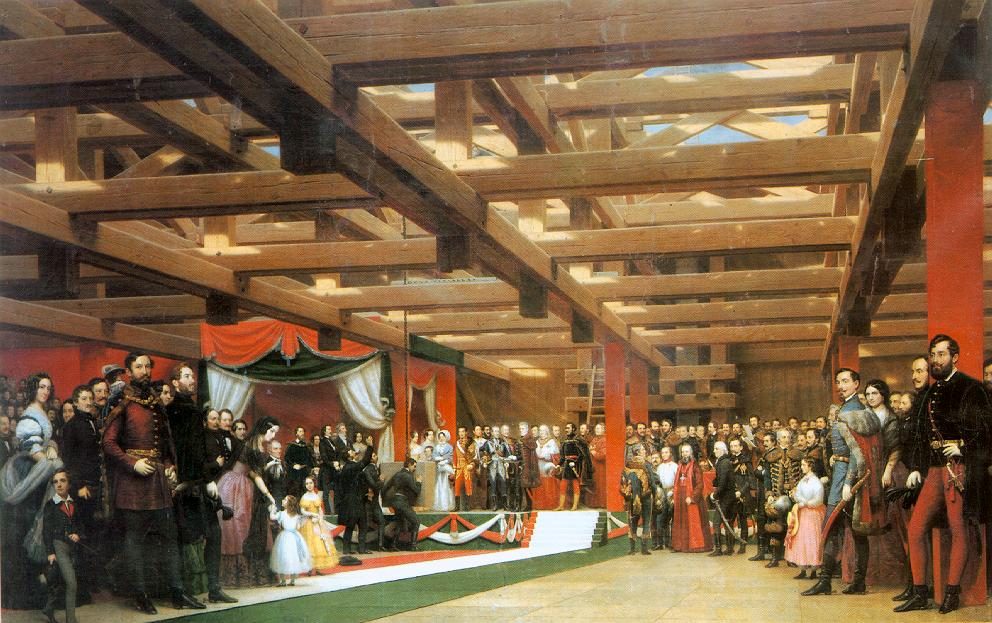
Miklós Barabás: Laying the foundation stone of the Chain Bridge (Source: Hungarian Electronic Library)
Mindenki számára ismerős az a jelenet, amikor Széchenyi az 1825-ös pozsonyi országgyűlés november 3-i alsótáblai ülésén felszólalt, s egy évi jövedelmét – körülbelül 60000 forintot – felajánlotta egy hazai tudós társaság létrehozásának céljára. Ez a nemes gesztus és hazafias szándék nemcsak a téren álló épületben ölt testet, hanem látható az épület keleti, Akadémia utcai homlokzatán, Holló Barnabás 1893-ban készült bronz domborművén is.
.jpg) The building of the Academy nowadays (Photo: Zsolt Dubniczky/pestbuda.hu)
The building of the Academy nowadays (Photo: Zsolt Dubniczky/pestbuda.hu)
.jpg) Count István Széchenyi offers his one-year income to establish the Academy at the 3 November 1825 session of the Diet of Pozsony. Bronze relief by Barnabás Holló made in 1893 on the eastern facade of the Academy building (Photo: Zsolt Dubniczky/pestbuda.hu)
Count István Széchenyi offers his one-year income to establish the Academy at the 3 November 1825 session of the Diet of Pozsony. Bronze relief by Barnabás Holló made in 1893 on the eastern facade of the Academy building (Photo: Zsolt Dubniczky/pestbuda.hu)
Although the institution was established in Pozsony, in the articles of association, however, Pest was designated as its seat. In the city on the left, however, it took four decades for the board to have their own headquarters. After the Learned Society, as it was called at the time, moved to Pest in 1830, it rented accommodation several times in today's Széchenyi Square, in the then Nákó Palace.
Nákó Palace, one of the most impressive buildings in Pest during the Reformation, stood on the site of today's Gresham Palace, opposite the Chain Bridge, on its axis. The building was built by wholesaler Antal Deron between 1827 and 1828, according to the plans of József Hild. Shortly afterwards, in 1833, Count János Nákó of Greek descent bought it for 230 thousand forints, and after that, it was owned by the family for almost forty years. In 1831, and even later, between 1862 and 1864, the Learned Society rented the first floor of the Nákó Palace.
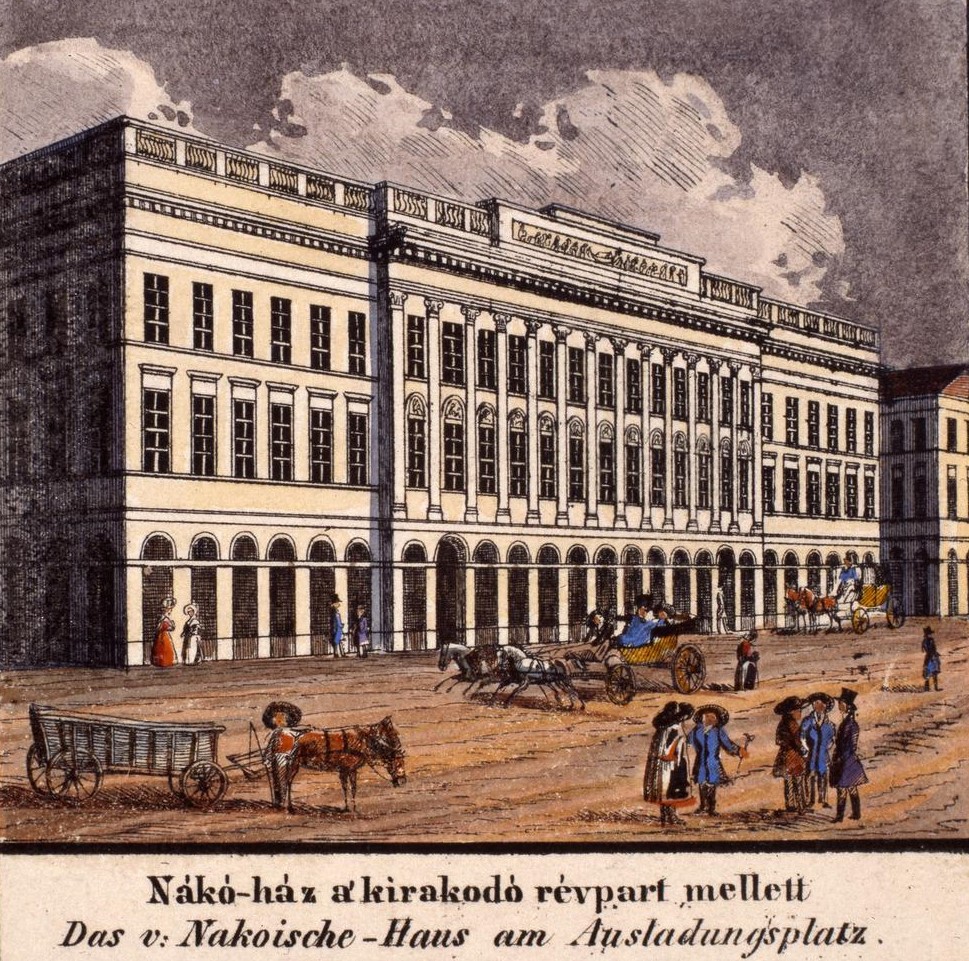
Facade of the Nákó Palace overlooking Kirakodó Square (today's Széchenyi István Square) based on a drawing by Carl Vasquez in 1837 (Source: FSZEK Budapest Collection)
.jpg)
Gresham Palace, built on the site of the former Nákó Palace (Photo: Zsolt Dubniczky/pestbuda.hu)
The first building of today's Széchenyi Square, defining the classicist cityscape, on the corner of József Attila (former Fürdő) Street, on the site of today's Ministry of the Interior, was the famous Diana Bathhouse by Ignác Pfeffer, built between 1822 and 1823 according to the plans of József Hild. Baths have been created on the ground floor of the elegant house, and apartments on the first floor. Between 1827 and 1832, Széchenyi was a permanent resident of the house - about which a plaque can be read on the wall of the building - where he rented a first-floor corner apartment overlooking the Danube and Fürdő Street, for 800 forints a year. Which was a significant amount at the time, and the count, who always kept financial considerations in mind, also considered a high price. In this mentioned corner apartment, Széchenyi wrote his masterpieces entitled Hitel, Világ, Stádium, which represent the modernisation of Hungarian economic literature and Hungary.
It happened here in 1828 that the count's horses rushed with the carriage into the Danube. Széchenyi was not injured because he was not sitting in the carriage, due to the garbage accumulating on the banks of the Danube at that time, the horses easily survived the misfortune, but the carriage broke into pieces.
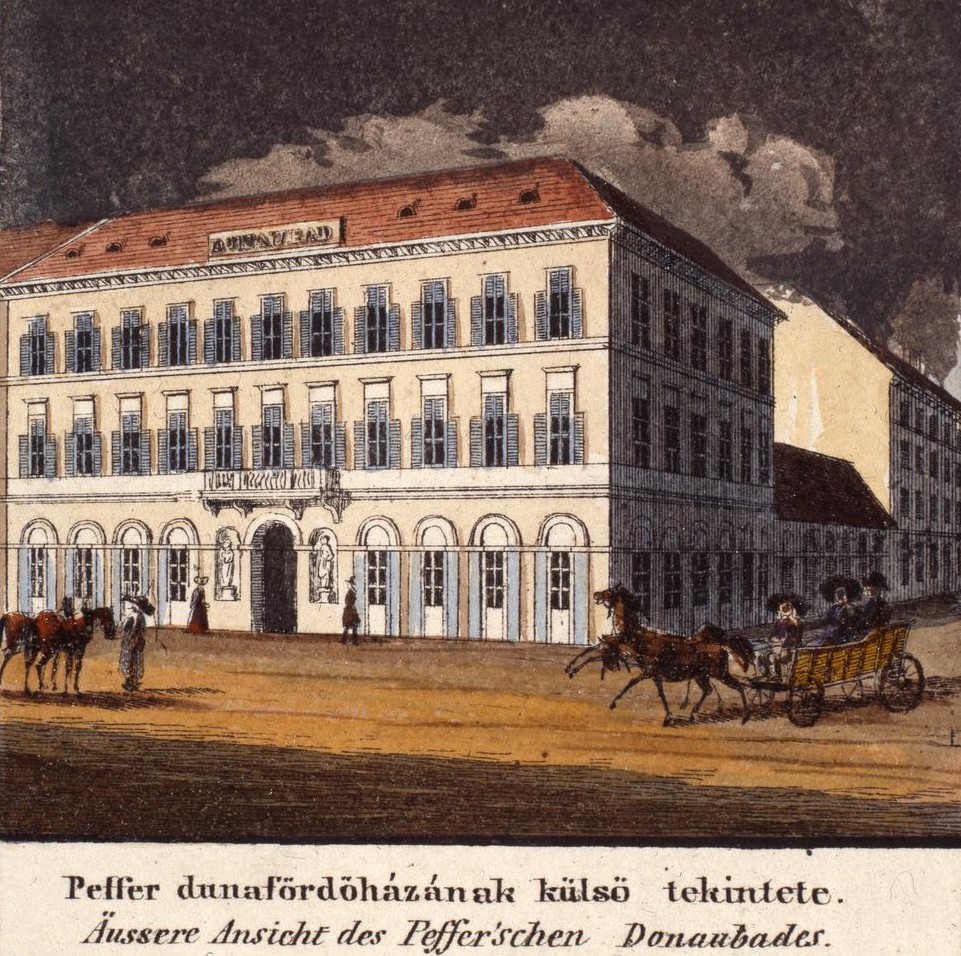
The Danube Bath of Ignác Pfeffer, the later Diana Bath in 1837 on a drawing by Carl Vasquez (Source: FSZEK Budapest Collection)
.jpg)
The headquarters of the former Hungarian Commercial Bank of Pest was built on the site of the Diana Bath between 1905 and 1909. Today, the Ministry of the Interior operates in the building (Photo: Zsolt Dubniczky/pestbuda.hu)
.jpg)
Today, a memorial plaque erected in 1941 on the facade of the building of the former Hungarian Commercial Bank of Pest, which houses the Ministry of the Interior, is about the count's residence in Pest and his participation in founding the bank (Photo: Zsolt Dubniczky/pestbuda.hu)
On the south side of the wall, next to the Diana Bath, between Dorottya and Mária Valéria (later Apáczai Csere János) Streets was the headquarters of the Pest Civil Trade Board, or as it was then called, the Börse building, later known as the Lloyd's Palace. The building, which plays an important role in the economic and political life of Hungary, was built between 1827 and 1830, also according to the plans of József Hild. Strongly protruding from the plain of the main facade overlooking the square, the ion-columned balcony, relying on an arcade structure, became one of the basic cityscape elements of Pest, which was also captured by many paintings and photographs.
To the Diet of Pozsony in 1825, not only the founding of the Academy connected but also the National Casino, also initiated by Széchenyi, which transferred its headquarters to Pest after the first meetings in Pozsony. On the initiative of Széchenyi, the Casino rented the first floor of the Trade Board building between 1831 and 1859.
But this building was also inhabited by the Count himself between 1832 and 1836. After his stay in the Diana Baths, Széchenyi probably arranged his new accommodation on the second floor of this building, overlooking the Danube. It was here that he began the preparatory work for the regulation of the Iron Gate, and in 1834 he set out on his tour of the Danube.
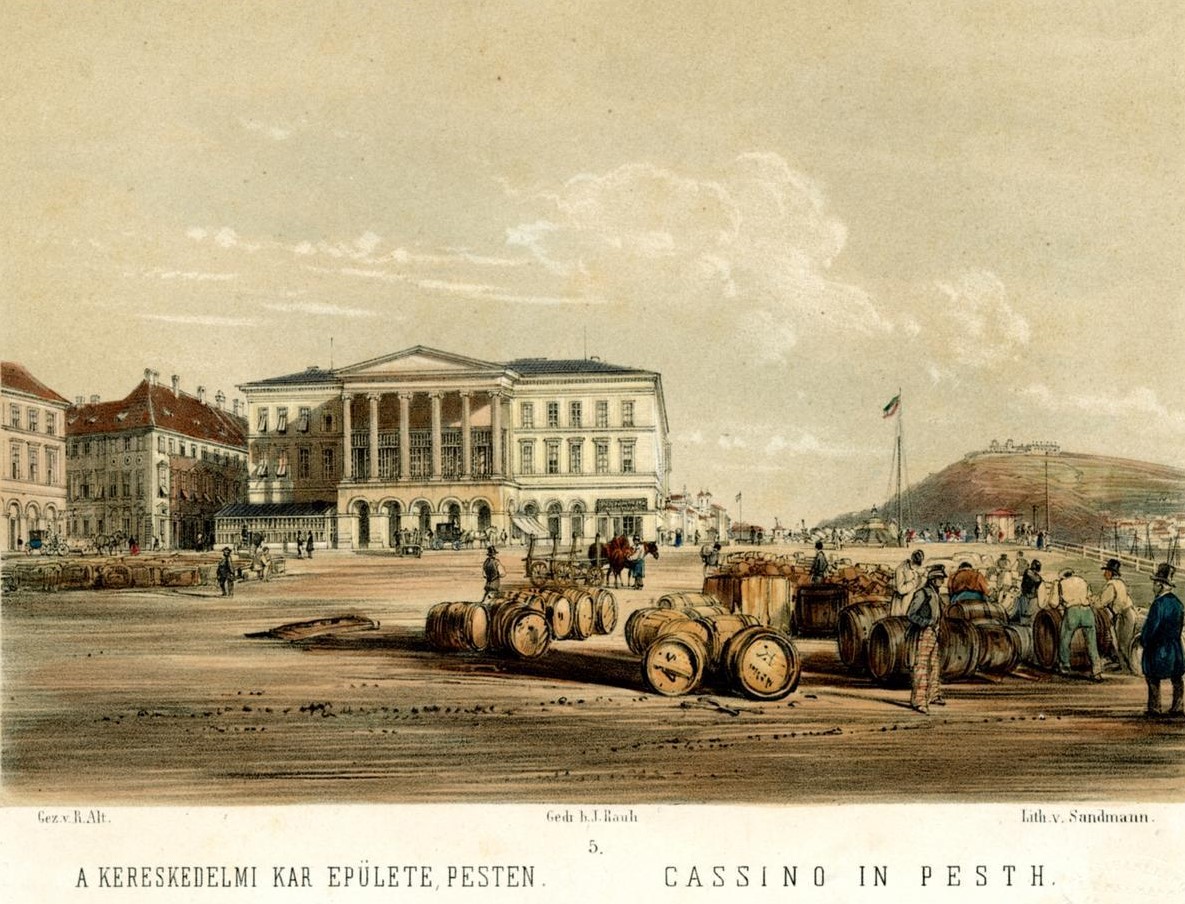
The building of the Pest Civil Trade Board, the later Lloyd's Building in Pest in 1850, by Rudolf Alt (Source: FSZEK Budapest Collection)
.jpg)
Sofitel Budapest Chain Bridge Hotel on the site of the former Lloyd's Building (Photo: Zsolt Dubniczky/pestbuda.hu)
During the Reformation, an elegant building, the Ullmann Palace stood next to the Academy building, on the corner of Széchenyi Square and Zrínyi Street. Currently, a seven-storey office building (formerly known as the Spenótház - Spinach House), built in the 1970s and rebuilt in the early 2000s stands there. The builder of the imposing 13-axis main facade overlooking the Danube, decorated with a balcony, was Móric Ullmann, a wholesaler from Pest, and the plans were also made by József Hild. One of the special beauties of the building was the palace's eight Corinthian columns, whose walls were decorated with relief compositions made in the late 1830s by the Italian sculptor Marco Casagrande, who aroused the admiration of contemporaries.
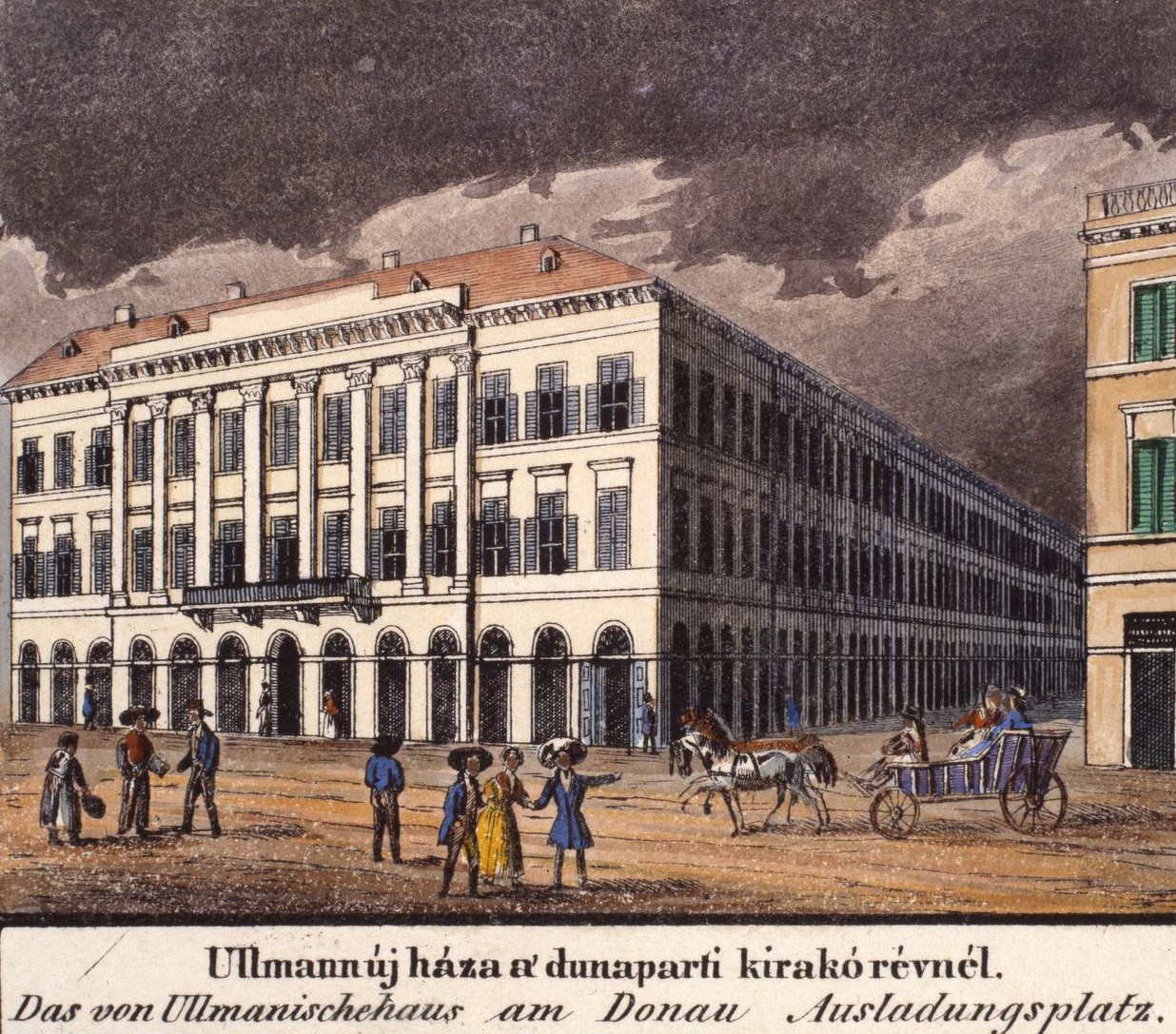
The Ullmann Palace in 1837 on a drawing by Carl Vasquez (Source: FSZEK Budapest Collection)
.jpg)
The building called Spinach House on the site of the Ullmann Palace, built in the 1970s and remodelled in the 2000s, nowadays (Photo: Zsolt Dubniczky/pestbuda.hu)
Móric Ullmann was not only a (tobacco) trader but also a banker, his name is associated with the founding of the first Hungarian commercial financial institution, the Hungarian Commercial Bank of Pest, established in 1841, which he also led as chairman, and as Pestbuda indicated previously, in which's establishment Széchenyi himself took an active part.
However, the banker and the count not only had an economic relationship with each other, but Széchenyi also lived in his house. After four years in the building of the Trade Board, between 1836 and 1848, the Ullmann House housed the Széchenyi family.
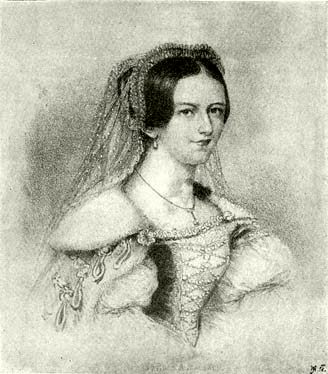
The wife of Count István Széchenyi, Seilern Crescence (Source: mek.oszk.hu)
The year 1836 marked a turning point in Széchenyi's private life. He could lead to the altar the woman to whom he felt platonic love for a good decade. Countess Seilern Crescence became a widow in 1834 - when Count Károly Zichy, 20 years older than her, died unexpectedly at the age of 56 - and after the mourning year, she married István Széchenyi, who nurtured tender feelings for her. The marriage took place in the church of Krisztinaváros in Buda on 4 February 1836, and during their stay in Pest-Buda, they lived for 12 years in the Ullmann House in Feldunasor.
This second-floor corner apartment on Zrínyi Street and the office with the balcony below could have been nice to Széchenyi because between 1842 and 1848 he was able to observe the construction of the Chain Bridge initiated by him. He also wrote the Kelet Népe (Eastern People) in dispute with Kossuth here, as well as his work on the regulation of the Tisza, which began in 1845, and in 1848 his works as Minister of Transport.
And, of course, the river itself, the Danube, crossing but at the same time connecting Pest-Buda, also played an important role in the life of the count. Exercise and sports, as well as its promotion, were just as important to him, and they belong to Széchenyi's life as much as his patriotic deeds. In addition to riding, his attention turned early to rowing and swimming. In the 1830s, at today's Pest bridgehead of Chain Bridge, he built the first Danube boat house, about which in 1842 the Buda fashion magazine called Spiegel also reported:
"On the Pest side, just below the construction of the head of the bridge, you can see a nicely built plank house, which extends into the Danube, on the side opening to the water, free, with a terrace at the top."
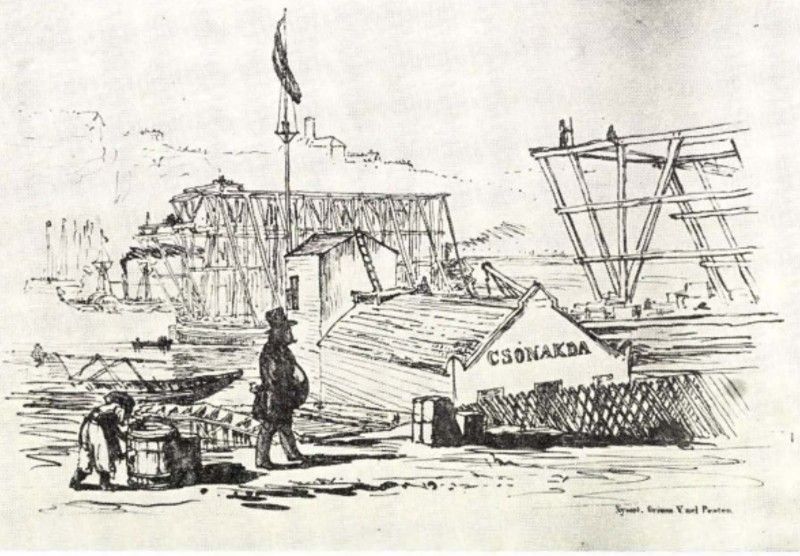
The boat house next to the Pest bridgehead of the Chain Bridge on the drawing of Miklós Barabás
And the count started swimming in the Danube and promoting it even earlier. As early as 22 April 1821, he wrote in his diary, “I bathed in the Danube, which made a great impression in Pest…,” and he repeated this several times later. Institutionalised forms of swimming also developed, and the first river pools appeared on the Danube already during the Reformation. On the Pest side, several swimming pools were already operating in the 1860s, including the swimming pool of Antal Káldor and József Scholcz, which awaited the citizens of Pest who wanted to bathe and swim, not far from today's Széchenyi Square, north of the Chain Bridge, along the Rudolf (today's Széchenyi) Embankment.
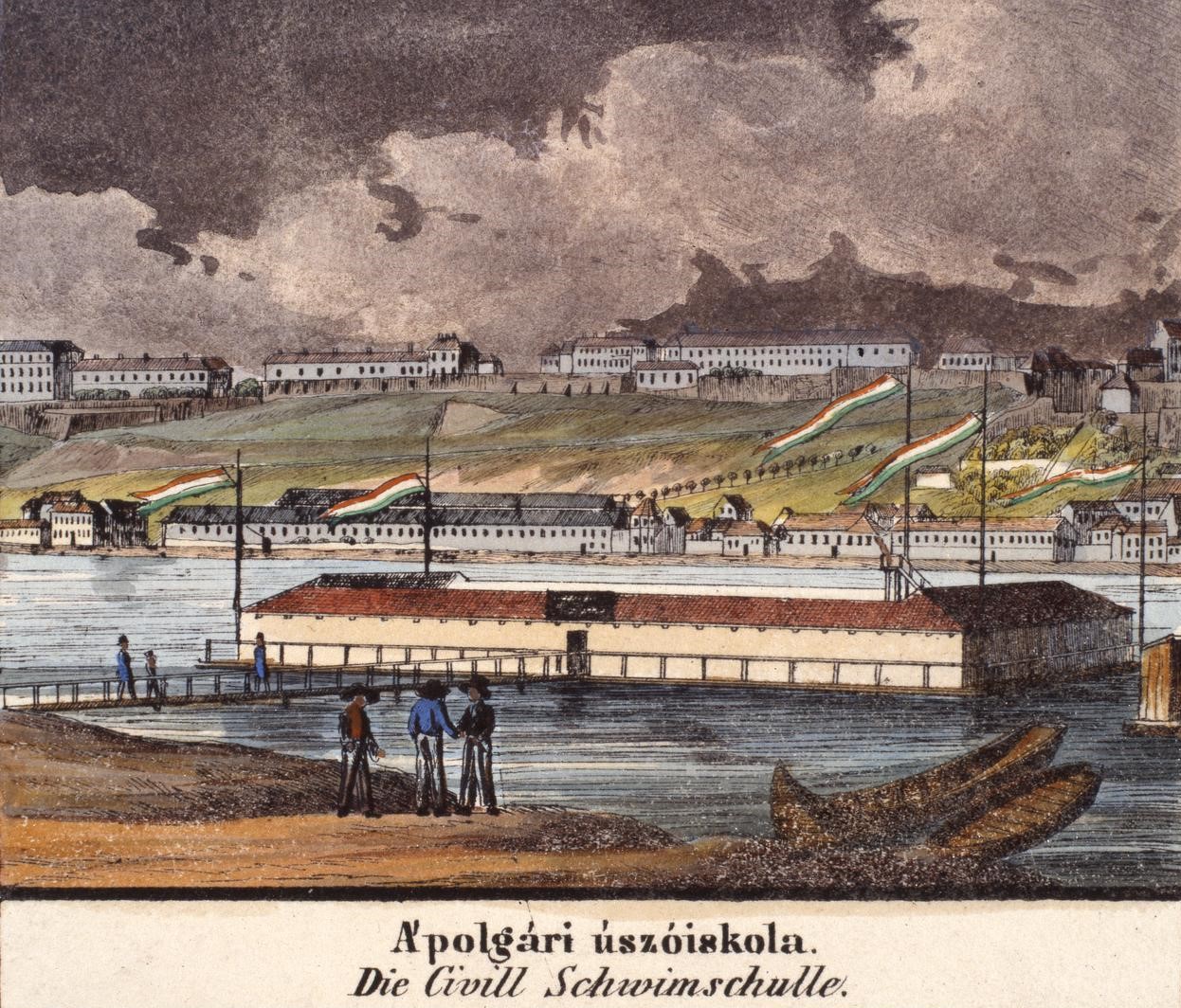
River pools have been operating on the Danube since the Reformation: the civic swimming school on the engraving by Carl Vasquez in 1837 (Source: FSZEK Budapest Collection)
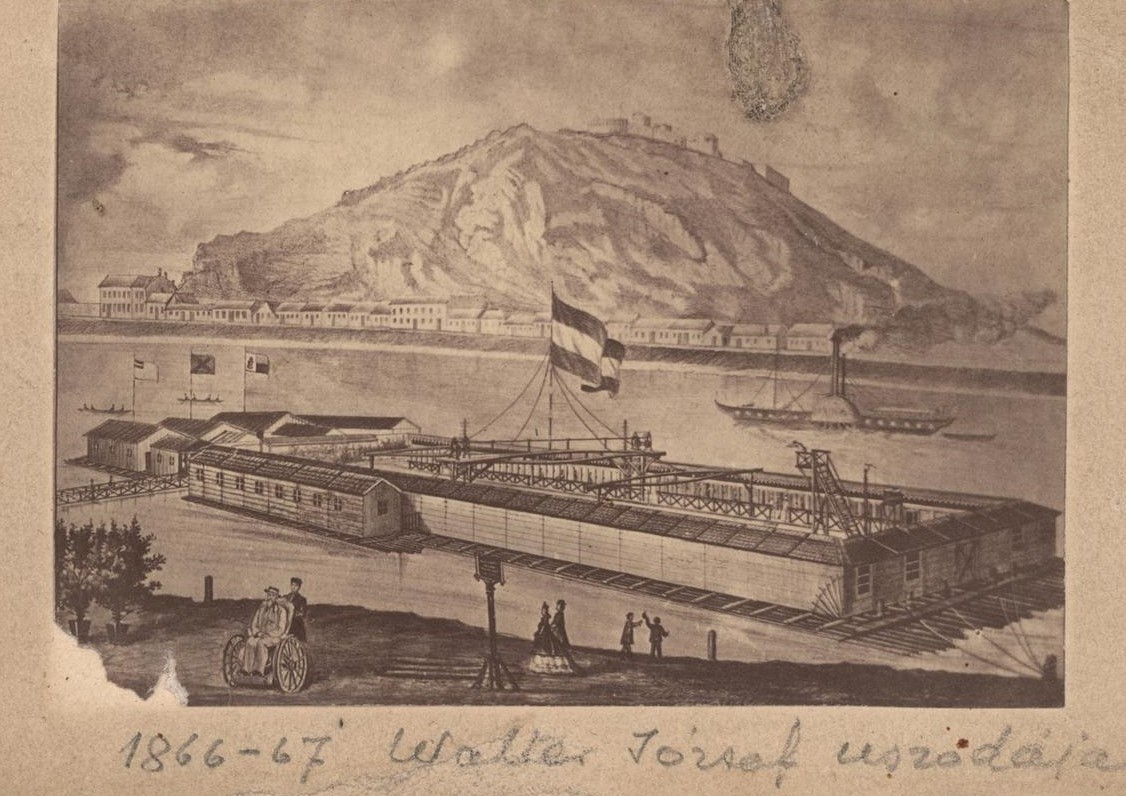
The swimming pool of József Walter in 1866-1867 in front of today's Március 15 Square. A similar one operated north of the Chain Bridge in front of the Rudolf, today's Széchenyi Embankment (Source: FSZEK Budapest Collection)
However, not only is the former Roosevelt Square now called Széchenyi but not far from here, two routes were previously named after the largest Hungarian. Széchenyi Street, which was given this name in the 1850s in the life of the Count, runs two streets north of the Academy. Of particular interest is that the street opens into the embankment, which is also named after Széchenyi. The section of the Pest embankment between the Academy and Jászai Mari Square has been called that since 1918, it was formerly called Rudolf Embankment.
.jpg)
The crossing of Széchenyi Street and the Széchenyi Embankment (Photo: Zsolt Dubniczky/pestbuda.hu)
Széchenyi's statue has adorned the square in front of the Academy since 1880, but there is another work nearby; in a lesser-known, less conspicuous, yet clearly visible place. In the sculpture booth of the former MÁV Design Institute building at the intersection of the Széchenyi Embankment and Zoltán Street, has been the work of sculptor József Somogyi since 1988, which can also be considered a pair of the Széchenyi Square sculpture. Instead of an ornamental Hungarian clothing, he depicts the count in a simple, bourgeois costume, as a “top-hatted saloon type”, and in his hands, unlike the statue in the square, he holds a folded roll of paper. Széchenyi's full-length bronze statue was erected by the Hungarian State Railways in memory of the former Minister of Transport.
.jpg)
The Széchenyi statue in the sculpture booth of the former MÁV Design Institute on the corner of the Széchenyi Embankment and Zoltán Street (Photo: Zsolt Dubniczky/pestbuda.hu)
Cover photo: Statue of István Széchenyi in front of the Academy building in the 1890s (Source: FSZEK Budapest Collection)

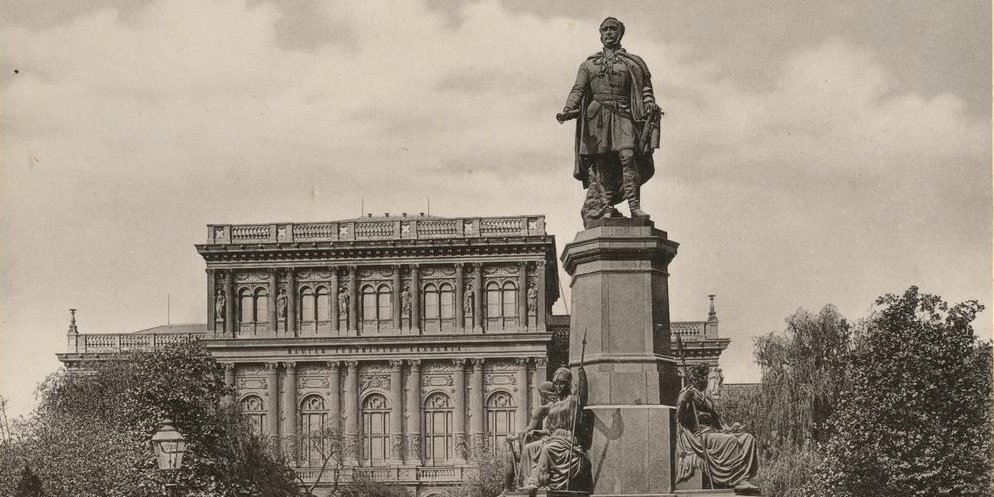



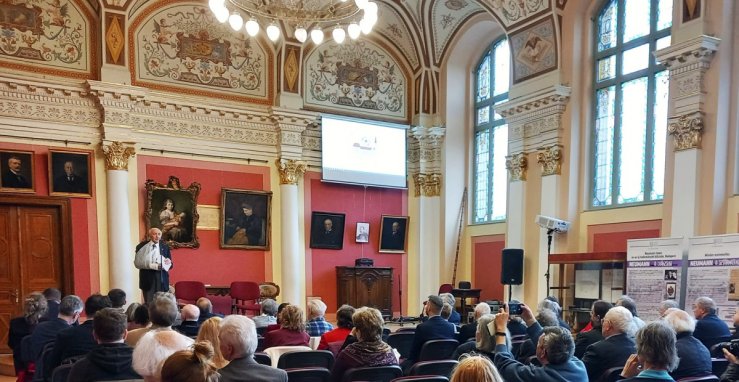






























Hozzászólások
Log in or register to comment!
Login Registration